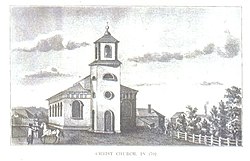Christ Church (Cambridge, Massachusetts)
Christ Church | |
 Christ Church in 1792. | |
 | |
| Location | Garden Street, Cambridge, Massachusetts |
|---|---|
| Coordinates | 42°22′31.0″N 71°7′14.0″W / 42.375278°N 71.120556°WCoordinates: 42°22′31.0″N 71°7′14.0″W / 42.375278°N 71.120556°W |
| Area | 0.5-acre (2,000 m2)[1] |
| Built | 1761 |
| Architect | Harrison, Peter |
| Part of | Cambridge Common Historic District (ID73000281) |
| NRHP reference No. | 66000140 |
| Significant dates | |
| Added to NRHP | October 15, 1966[2] |
| Designated NHL | October 9, 1960[3] |
| Designated CP | April 13, 1973 |
Christ Church, at Zero Garden Street in Cambridge, Massachusetts, U.S., is a parish of the Episcopal Diocese of Massachusetts. Built in 1760–61, it was designated a National Historic Landmark as one of the few buildings unambiguously attributable to Peter Harrison, the first formally trained architect to work in the British colonies.
History[]
The congregation was founded in 1759 by members of the King's Chapel who lived in Cambridge to have a church closer to their homes and to provide Church of England services to students at Harvard College across Cambridge Common. The church's first rector was East Apthorp, and most of the founding members lived along the nearby Tory Row, now called Brattle Street.
The church was designed by noted colonial era architect Peter Harrison, who also designed the King's Chapel in Boston, and is one of a small number of surviving buildings attributable to him. Its wooden frame rests on a granite foundation built from ballast stones from ships arriving at Boston Harbor. The church was originally finished in a sanded paint treatment to give the appearance of a traditional English stone church.
During the American Revolution Christ Church was attacked by dissenting colonials for its Tory leanings, but it was also the site of a prayer service which George and Martha Washington attended while quartered in the nearby mansion now known as Longfellow House–Washington's Headquarters National Historic Site. The church was closed, and its organ melted down for bullets during the Revolution.
For several years after the American Revolution, the church stood empty. In the later years of the eighteenth century the church was re-opened as an Episcopal Church and has remained so. The original chapel was expanded in 1857 to accommodate a larger congregation and to help raise funds for the church by expanding pew rental income. The church was dramatically redecorated in 1883, but it was restored to its original simplicity in 1920.[4]
Generations of Harvard students from Richard Henry Dana Jr., author of Two Years Before the Mast, to Teddy Roosevelt, who was asked not to continue as a Sunday School teacher because he would not become an Episcopalian, have made Christ Church their parish home during their studies.
The church was declared a National Historic Landmark in 1960,[1][3] and was listed on the National Register of Historic Places in 1966.[2]
To the east adjacent to the church at the corner of Garden Street and Massachusetts Avenue is a separate historic landmark known as the Old Burying Ground, not affiliated with the chapel or any other church; it pre-dates the present church by over a century.
Christ Church has a long history of social activism, supporting the civil rights movement, the peace movement, and ministries of social justice. In April 1967 the Reverend Martin Luther King Jr. and Doctor Benjamin Spock were denied access to a building at Harvard University to hold a press conference denouncing the Vietnam War, but the Reverend Murray Kenney welcomed them to Christ Church; a plaque in the parish hall commemorates the event. Another activist to speak at Christ Church was Jesse Jackson, who spoke as part of a Martin Luther King Jr. celebration in 2004.
Gallery[]
Church interior.

View of the Cambridge Common, ca. 1808–09, with Harvard College on the left and Christ Church on the right.

Exterior in 2012.

Christ Church, 1759–61, ca. 1895–1905. Archive of Photographic Documentation of Early Massachusetts Architecture, Boston Public Library.
See also[]
- National Register of Historic Places listings in Cambridge, Massachusetts
- List of National Historic Landmarks in Massachusetts
References[]
- ^ a b Patricia Heintzelman and Charles Snell (October 10, 1975) National Register of Historic Places Inventory-Nomination: Christ Church, National Park Service and Accompanying seven photos, exterior and interior, from 1967 and 1975
- ^ a b "National Register Information System". National Register of Historic Places. National Park Service. January 23, 2007.
- ^ a b "Christ Church (Cambridge)". National Historic Landmark summary listing. National Park Service. Archived from the original on 2009-06-06. Retrieved 2008-08-06.
- ^ http://www.cccambridge.org/History.html[permanent dead link]
External links[]
 Media related to Christ Church (Cambridge, Massachusetts) at Wikimedia Commons
Media related to Christ Church (Cambridge, Massachusetts) at Wikimedia Commons- Christ Church Website
- Illus. by Winslow Homer of bells
- National Historic Landmarks in Cambridge, Massachusetts
- Episcopal church buildings in Massachusetts
- Churches on the National Register of Historic Places in Massachusetts
- Churches in Cambridge, Massachusetts
- Harvard Square
- 18th-century Episcopal church buildings
- Historic district contributing properties in Massachusetts
- National Register of Historic Places in Cambridge, Massachusetts






